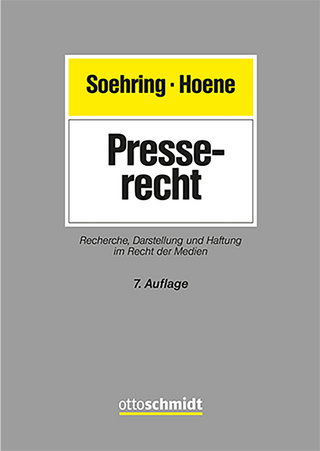
The Law of Public Communication
Seiten
2024
|
13th edition
Routledge (Verlag)
978-1-032-68853-4 (ISBN)
Routledge (Verlag)
978-1-032-68853-4 (ISBN)
This thoroughly updated classic textbook provides an overview of communication and media law, including the most current legal developments. It explains laws affecting the daily work of writers, broadcasters, public relations practitioners, photographers, bloggers, and other public communicators.
This thoroughly updated classic textbook provides an overview of communication and media law, including the most current legal developments. It explains laws affecting the daily work of writers, broadcasters, public relations practitioners, photographers, bloggers and other public communicators.
By outlining statutes and cases in an accessible manner, even to students studying law for the first time, the authors ensure that readers acquire a firm grasp of the legal issues affecting the media. The book examines legal topics such as libel, privacy, intellectual property, obscenity and access to information, considering the development and current standing of relevant laws and important cases. It examines how these laws affect public, political and commercial communication. The 13th edition covers contemporary U.S. Supreme Court cases, including the true threats case Counterman v. Colorado, the Andy Warhol fair use case and the Jack Daniel's trademark parody case. It also presents the Biden administration's revision of policy on the use of subpoenas and search warrants to uncover reporters' confidential sources along with the gag orders imposed by courts handling criminal and civil trials in which Donald Trump is a defendant. Further cases explored include the attacks by legislatures against the LGBTQ community, exemplified by a Tennessee law banning drag performances, and the emerging issues presented by artificial intelligence and the content moderation policies of social media platforms.
The Law of Public Communication is an ideal core textbook for undergraduate and graduate courses in communication law and mass media law.
A test bank for instructors is available at www.routledge.com/9781032676388
This thoroughly updated classic textbook provides an overview of communication and media law, including the most current legal developments. It explains laws affecting the daily work of writers, broadcasters, public relations practitioners, photographers, bloggers and other public communicators.
By outlining statutes and cases in an accessible manner, even to students studying law for the first time, the authors ensure that readers acquire a firm grasp of the legal issues affecting the media. The book examines legal topics such as libel, privacy, intellectual property, obscenity and access to information, considering the development and current standing of relevant laws and important cases. It examines how these laws affect public, political and commercial communication. The 13th edition covers contemporary U.S. Supreme Court cases, including the true threats case Counterman v. Colorado, the Andy Warhol fair use case and the Jack Daniel's trademark parody case. It also presents the Biden administration's revision of policy on the use of subpoenas and search warrants to uncover reporters' confidential sources along with the gag orders imposed by courts handling criminal and civil trials in which Donald Trump is a defendant. Further cases explored include the attacks by legislatures against the LGBTQ community, exemplified by a Tennessee law banning drag performances, and the emerging issues presented by artificial intelligence and the content moderation policies of social media platforms.
The Law of Public Communication is an ideal core textbook for undergraduate and graduate courses in communication law and mass media law.
A test bank for instructors is available at www.routledge.com/9781032676388
William E. Lee is Professor Emeritus of Journalism at the Grady College of Journalism and Mass Communication at the University of Georgia, USA. Daxton R. Stewart is an attorney and Professor of Journalism at the Bob Schieffer College of Communication at Texas Christian University, USA. Jonathan Peters is an attorney and the Chair of the Department of Journalism at the University of Georgia, USA, where he teaches and researches media law.
1. Public Communication and the Law 2. The First Admendment 3. Methods of Control 4. Libel 5. Privacy 6. Intellectual Property 7. Political Speech 8. Commercial Speech 9. Obscenity and Indecency 10. The Media and the Judiciary 11. Protection of News Sources, Notes and Recordings 12. Access to Information
| Erscheinungsdatum | 10.07.2024 |
|---|---|
| Zusatzinfo | 4 Tables, black and white; 12 Line drawings, black and white; 24 Halftones, black and white; 36 Illustrations, black and white |
| Verlagsort | London |
| Sprache | englisch |
| Maße | 178 x 254 mm |
| Gewicht | 1180 g |
| Themenwelt | Geisteswissenschaften ► Geschichte |
| Recht / Steuern ► EU / Internationales Recht | |
| Recht / Steuern ► Privatrecht / Bürgerliches Recht ► Medienrecht | |
| Sozialwissenschaften ► Kommunikation / Medien ► Kommunikationswissenschaft | |
| Sozialwissenschaften ► Kommunikation / Medien ► Medienwissenschaft | |
| ISBN-10 | 1-032-68853-X / 103268853X |
| ISBN-13 | 978-1-032-68853-4 / 9781032688534 |
| Zustand | Neuware |
| Informationen gemäß Produktsicherheitsverordnung (GPSR) | |
| Haben Sie eine Frage zum Produkt? |
Mehr entdecken
aus dem Bereich
aus dem Bereich
Recherche, Darstellung und Haftung im Recht der Medien
Buch | Hardcover (2024)
Verlag Dr. Otto Schmidt KG
CHF 179,95
für Studium, Fachanwaltsausbildung und Praxis
Buch | Softcover (2023)
C.H.Beck (Verlag)
CHF 109,95


